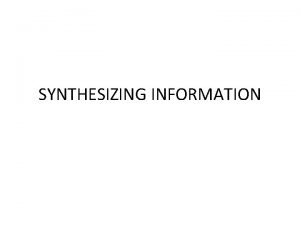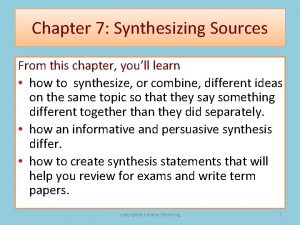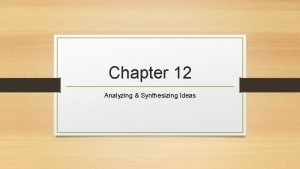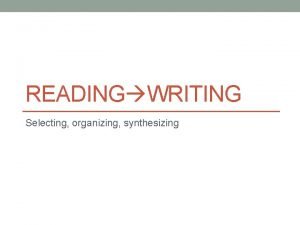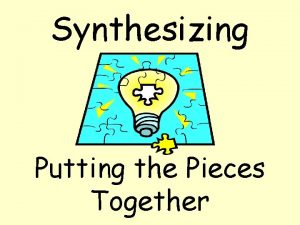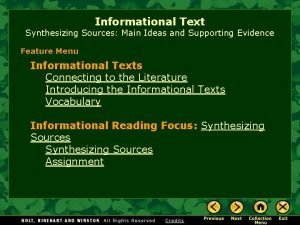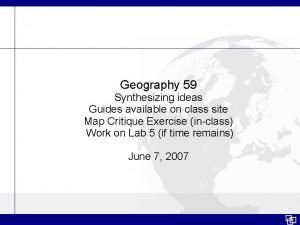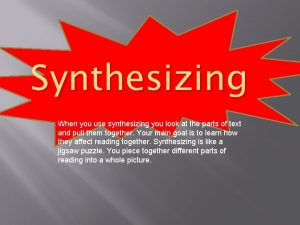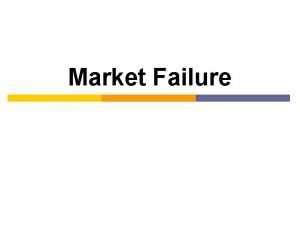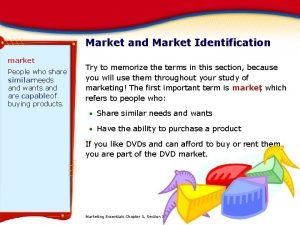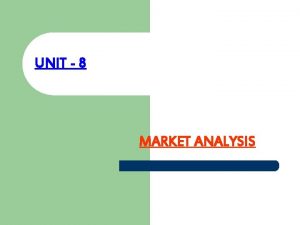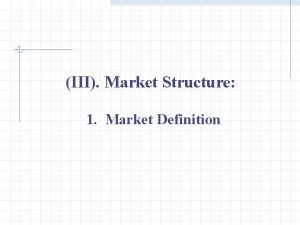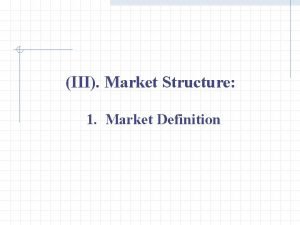Synthesizing Lesson 1 Lesson 2 You the Market























- Slides: 23

Synthesizing Lesson 1 Lesson 2: You & the Market

BENITEZ BO’S & 1. In what specific ways has Benitez displayed the entrepreneurial mindset in building up Bo’s Coffee? Explain. 2. What opportunity sources (Macro/ Micro) led Benitez to the business opportunity he is in? What entrepreneurial uncertainties or threats did he undergo in pursuit of this opportunity and how did he address them? 3. How has his goal orientation shaped his business typology when he started? Has Bo’s typology changed? Why do you say so?

YOU & THE MARKET § Identify the market problem to be solved or the market need to be met; and § Propose solution/s in terms of product/s and service/s that will meet the need using techniques on seeking, screening, and seizing opportunities

§ In general: Specific location where buying and selling takes place, such as § Supermarket or a flea market § a situation wherein… § A group of buyers and sellers who have the potential to trade with each other, § An exchange of goods and/or services occurs § Entrepreneurs & Consumers interact

§PHASE 1: Narrow down your opportunity source Macro VS Micro Industry? Personal Motive? Consumer?

Tip: consider Personal motive & Consumer need ü What are you good at? What can you produce? ü Is it something a consumer needs? üIs it current? Sustainable? Game-changing? üWill it gain you profit & growth? List 3 possibilities

üWhat is my vision? (Generalize) Ex: SONY Vision: Using our unlimited passion for technology, content & service to deliver groundbreaking new excitement and entertainment, as only SONY can. What’s YOUR VISION in line with your product?

ü How do I achieve this vision (Mission)? … Write down… Ex: SONY A company that inspires and fulfills your curiosity üWhat positive values/ benefits will my product/ service build or provide? Ex. SONY üVALUES: Corporate Social Responsibility thru… - Innovation - Sound business practices - Contributing to a sustainable society

üMacro? Micro? Multiples? ü Physical OR virtual? üSurvey / Focus Group Discussion Activity: SNAP SURVEY: - Ask 10 people in class if they would want to buy your product? - If yes/ no or IDK – ask why… note it down

üUse the 12 Rs Matrix of Opportunity Screening üSet 1 Criteria 1 -10 (+) the higher the better the choice üSet 2 criteria 11 -12 (-) the higher, the more threats/ difficulties stand in your way üActivity: SWAP-Revise Rating-Feedback

TYPES OF COMPETITION

§ a firm that has potential to take your customers (Reduce your market share; tap into a similar market segment as you) § They “strategically” plan and execute competition via: üPRODUCTS üBUSINESS MODEL (operations/ üPOSITIONING system) üDISTRIBUTION üCOSTS of production üREPUTATION (BRANDING)üPRICING

§ Direct - A firm that sells the same products and services as you in the same markets. For example? Property development… Chinese cuisine… Laptops/ Netbooks…

§ Indirect A firm that sells different categories of products and services but are in the same industry and same markets. Ex: Coffee shop VS Restaurant For example? Furniture industry… Construction Industry… Publishing Industry…

§ Replacement § A firm that sells products and services that are in a different industry that could be used as a substitute for your products. For example, a restaurant and a supermarket in the same city. For example? HOTEL vs… AIRLINE vs… GAMING CONSOLE vs…

§ Potential § A direct, indirect or replacement competitor that currently has no distribution in your markets (Philippines/ Cebu). For example…

Future § A firm that has business capabilities that would allow them to quickly take market share if they entered your markets. For example, a large technology company may be perceived as a competitor of smaller technology firms even if they haven't entered their market yet. For example?

§ Understand the market § Improve your targeting of customers § Forecast the potential for the market § Figure out how the economic climate impacts the market § Understand what competitors are offering § Keep tabs on competitors' prices § Determine offerings in ancillary markets § Find new customers

§ STEP 1: Determine means of gathering competitor data àIn-house (DIY, internally sourced gathering)? OR Outsource via consultant/ research firm? üWhen do you go “IN-HOUSE”? When do you OUTSOURCE? ü What are the advantages? Disadvantages?

§ Step 2: For in-house information gathering, conceptualize a framework (what will you find out? ) Customer/market segment Product attributes/ features Marketing practices Market performance Product strengths and weaknesses product value proposition (ex. BDO – “We find ways”… VS BPI – “Make the best happen. ”

§ Step 3: Select your targets § Step 4: Data gathering -“Secret shopping” (product assessment) – yourself/ other customers § Step 5: Monitor your competitor § Any changes in messaging and overall visual identity § New products, services and/or pricing § Short-term or long-term promotions § New advertising or other outbound communications § New geographies § New team members § Significant sales wins and losses

§ TOOLS for Gathering & Monitoring: àWeb audits àPublic records àSecondary sources: articles, industry reports à Customer interviews

Low PRICE Mid High Quality VS. Price Analysis Low Quality Mid
 Leader challenger follower nicher
Leader challenger follower nicher Market segmentation lesson plan
Market segmentation lesson plan Synthesizing texts
Synthesizing texts Process of synthesizing information
Process of synthesizing information Perbedaan ringkasan abstrak dan sintesis
Perbedaan ringkasan abstrak dan sintesis Synthesizing mind example
Synthesizing mind example Synthesizing sources examples
Synthesizing sources examples Synthesizing ideas in an informational text
Synthesizing ideas in an informational text Synthesizing in reading
Synthesizing in reading Reading strategy synthesizing
Reading strategy synthesizing After putting the pieces together, what do they look like?
After putting the pieces together, what do they look like? Synthesizing ideas in an informational text
Synthesizing ideas in an informational text Shiry ginosar
Shiry ginosar Flow map
Flow map Hát kết hợp bộ gõ cơ thể
Hát kết hợp bộ gõ cơ thể Ng-html
Ng-html Bổ thể
Bổ thể Tỉ lệ cơ thể trẻ em
Tỉ lệ cơ thể trẻ em Gấu đi như thế nào
Gấu đi như thế nào Chụp phim tư thế worms-breton
Chụp phim tư thế worms-breton Bài hát chúa yêu trần thế alleluia
Bài hát chúa yêu trần thế alleluia Môn thể thao bắt đầu bằng từ chạy
Môn thể thao bắt đầu bằng từ chạy Thế nào là hệ số cao nhất
Thế nào là hệ số cao nhất Các châu lục và đại dương trên thế giới
Các châu lục và đại dương trên thế giới



